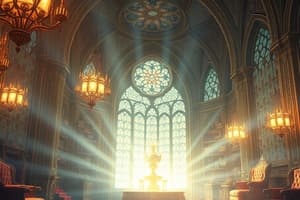Podcast
Questions and Answers
What happens to a ray of light when it travels from a slow to a fast medium past the critical angle?
What happens to a ray of light when it travels from a slow to a fast medium past the critical angle?
- It reflects back into the slow medium. (correct)
- It is absorbed by the medium.
- It bends away from the normal.
- It continues in a straight line.
The angle of incidence is always equal to the angle of reflection.
The angle of incidence is always equal to the angle of reflection.
True (A)
What are the primary light colors?
What are the primary light colors?
Red, Blue, Green
The complementary color to the primary light color red is __________.
The complementary color to the primary light color red is __________.
Match the primary light colors with their corresponding secondary colors:
Match the primary light colors with their corresponding secondary colors:
What type of mirror always produces a virtual image that is smaller than the object?
What type of mirror always produces a virtual image that is smaller than the object?
Incandescence is a type of light emission from chemical reactions.
Incandescence is a type of light emission from chemical reactions.
What is the distance from a mirror to its focal point called?
What is the distance from a mirror to its focal point called?
Light emitted from living organisms is known as __________.
Light emitted from living organisms is known as __________.
Match the terms with their definitions:
Match the terms with their definitions:
Which one of the following is an example of a primary additive color?
Which one of the following is an example of a primary additive color?
A non-luminous object produces its own light.
A non-luminous object produces its own light.
The angle between the incident ray and the normal is called the __________.
The angle between the incident ray and the normal is called the __________.
What is the correct order of the parts of the electromagnetic spectrum starting with the least energetic?
What is the correct order of the parts of the electromagnetic spectrum starting with the least energetic?
Ultraviolet light is primarily used for medical imaging.
Ultraviolet light is primarily used for medical imaging.
List the seven colors identified in the visible spectrum of white light.
List the seven colors identified in the visible spectrum of white light.
When light passes from a faster medium to a slower medium, it bends ___.
When light passes from a faster medium to a slower medium, it bends ___.
Match each electromagnetic wave with its primary usage:
Match each electromagnetic wave with its primary usage:
What are the four characteristics of an image formed by a convex mirror?
What are the four characteristics of an image formed by a convex mirror?
What happens to an image in a concave mirror when the object is placed beyond the focal point?
What happens to an image in a concave mirror when the object is placed beyond the focal point?
Convex mirrors provide a small field of view, making them ideal for sharp turns in parking garages.
Convex mirrors provide a small field of view, making them ideal for sharp turns in parking garages.
Flashcards
Normal (in optics)
Normal (in optics)
A line drawn perpendicular to the surface at the point where the incident ray strikes the surface.
Plane mirror
Plane mirror
The smooth, flat surface that reflects light regularly.
Incandescence
Incandescence
Light emitted from a material being heated.
Angle of Incidence
Angle of Incidence
Signup and view all the flashcards
Angle of Reflection
Angle of Reflection
Signup and view all the flashcards
Focal Length
Focal Length
Signup and view all the flashcards
Incident Ray
Incident Ray
Signup and view all the flashcards
Diffuse Reflection
Diffuse Reflection
Signup and view all the flashcards
Electromagnetic Spectrum
Electromagnetic Spectrum
Signup and view all the flashcards
Microwave
Microwave
Signup and view all the flashcards
Radio Waves
Radio Waves
Signup and view all the flashcards
Infrared
Infrared
Signup and view all the flashcards
Visible Light
Visible Light
Signup and view all the flashcards
Ultraviolet (UV) Light
Ultraviolet (UV) Light
Signup and view all the flashcards
X-rays
X-rays
Signup and view all the flashcards
Gamma Rays
Gamma Rays
Signup and view all the flashcards
Refraction
Refraction
Signup and view all the flashcards
Primary colours of light
Primary colours of light
Signup and view all the flashcards
Secondary colours of light
Secondary colours of light
Signup and view all the flashcards
Mixing primary light colours
Mixing primary light colours
Signup and view all the flashcards
Complementary colour to red
Complementary colour to red
Signup and view all the flashcards
Study Notes
Optics Test Review
- Reflection:
- The angle of incidence equals the angle of reflection
- The incident ray, reflected ray, and normal are on the same plane
- Electromagnetic Spectrum (least to most energetic):
- Radio waves
- Microwaves
- Infrared
- Visible light
- Ultraviolet
- X-rays
- Gamma rays
- Electromagnetic Waves and Their Uses:
- X-rays: Medical imaging
- Ultraviolet light: Vitamin D
- Radio waves: Telecommunication, TV remote control
- Infrared light: Radar, theatre/concert effects
- Microwaves: TV remote control, radar
- Gamma rays: Cancer treatment
- Visible light: Medical imaging, theatre/concert effects
- Primary and Secondary Colors:
- Primary colors: Red, green, blue
- Secondary colors: Cyan, yellow, magenta
- Combining primary colors produces white light
- Combining secondary colors produces white light
- Visible Spectrum Colors:
- Red, orange, yellow, green, blue, indigo, violet
- Reflection Types:
- Specular reflection: Smooth surfaces, clear reflections (e.g., mirror)
- Diffuse reflection: Irregular surfaces, scattered reflections (e.g., a wall)
- Luminous and Non-luminous Objects:
- Luminous objects produce their own light (e.g., sun, lightbulb)
- Non-luminous objects reflect light (e.g., moon, table)
- Types of Mirrors:
- Plane mirror: Flat surface, creates upright, virtual images
- Convex mirror: Bulging outward, creates smaller, virtual images, wide field of view
- Concave mirror: Curves inward, image depends on object position (upright or inverted)
Laws of Reflection and Refraction
- Refraction:
- Light bends when traveling from one medium to another
- When light moves to a slower medium it bends toward the normal.
- Total Internal Reflection:
- Occurs when light traveling from a slower to faster medium, bends past the critical angle, and is reflected back into the slower medium.
- Concave Mirrors:
- If the object is between the focal point and mirror, the image is upright and magnified, located behind the mirror (virtual).
- If the object is beyond the focal point, the image is inverted, real, and smaller, located in front of the mirror.
- Convex Mirrors:
- The image is always upright and smaller, and virtual. The location is behind the mirror.
- Color Mixing Summary:
- Red, green and blue light create white light (or when superimposed).
- Red light can not create a green color appears black.
Additional Questions
- Complementary Colors:
- Red's complementary color is cyan
- Color Filters:
- A green filter followed by a yellow filter, would result in a yellow color (filtering white light)
- Ray Diagrams: Students are required to draw and label ray diagrams depicting how light reflects off mirrors and lenses. Analyze these diagrams to determine image characteristics.
Studying That Suits You
Use AI to generate personalized quizzes and flashcards to suit your learning preferences.




